 |
||
|
||
| ||
At the end of February 2002 the German company TerraTec, a well-known manufacturer of multimedia and professional audio equipment, announced a revolution in sound having released its new DMX 6fire 24/96 sound card with a commutation unit. DMX means that the device belongs to multimedia sound cards, 6fire - 6 analog-outs, 24/96 is a 24 bit 96 kHz format - it is marked this way in the sphere of professional audio equipment. 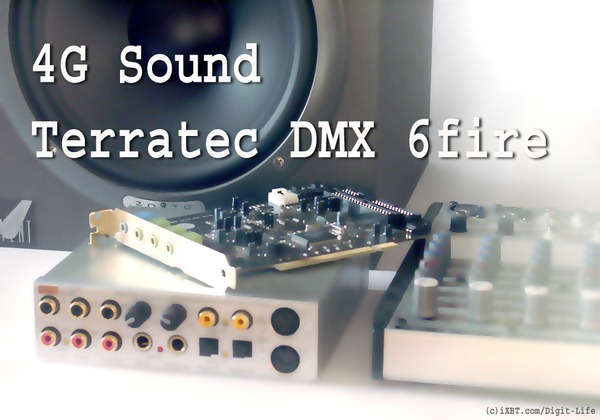 Until this event we had the Creative's Audigy Platinum eX as a multimedia leader. At the end of the last year the Platinum eX got the "iXBT.com/Digit-Life 2001 Award" as the best multimedia sound card of the year. Today we are going to watch a hot fight of two heavy-weights of the sub-$250 category. In several minutes we will take a look at competition of multimedia sound cards of the Hi-End class. In this duel we have two products which arrived into the same market sector from two different worlds.
Both cards have similar prices and appearance. Both have their light versions (Audigy Player and 6fire LT) deprived of an external commutation unit and with a light suite of software, but absolutely identical to their elder brothers. For details on the Audigy Platinum eX see this review. Today we will speak mostly on the new 6fire card, but in comparison with the last year's champion.  TerraTec promotes its new 6fire card under the slogan of 4G Sound. Here is how TerraTec divides sound cards into generations:
 We have supplemented this scheme with one more generation. Let's call it "3.5":
Also, I can predict the future sound card generation, 7.1G Sound. Perhaps, it will be a card with a wireless digital connection to speakers, voice management and unlimited Internet access, self-downloadable drivers updates and newly appeared compositions in the new multichannel compression format MPEG 7.1 Layer 2496, without quality losses. :) What are 24 bits 96 kHz for?There are several answers. TerraTec attracted experts to cover this subject, and now you can get an idea on these 24 bits 96 kHz:  On the other hand, the most obvious answer comes from the practice, i.e. our listening tests and measurements in the RMAA program. First of all, converters supporting 24/96 have a newer design and a higher price. That is why they record and play sound noticeably better in all modes, including good old 16 bits 44 kHz (games, CD, MP3) and 16 bits 48 kHz (DVD). Secondly, 24/96 will be useful in sampling audio records with further processing. Then it's possible to make downsampling to 16/44, but it's always better to sample with some reserve. It's like in the photo world. If you need a high-quality photo of 640x480 you know quite well which device should be used for digital photo shooting: a web camera of the same low resolution or an expensive digital camera which has some reserve in resolution and quality. In the latter case it's not difficult to process and reduce the image to the required parameters, but the result will certainly differ although the final parameters are identical. By the way, all inexpensive DACs supporting 24/96 have better characteristics exactly in the 16/44 mode. It's connected with operation of 1-bit converters with oversampling and filtering. That is why it's not enough to teach a DAC to receive data in this format and then announce the 24/96 support to make this format worthwhile given the output sound quality reached. On the other hand, the mass industry has just started moving toward the formats of extended precision of data representation. And in the currently dormant sphere of high-quality sound new ideas and new formats become a banner of marketing crusades of hardware makers pursuing users' wallets. Be careful, my friends. Well-known Asian makers of Hi-End devices for PCs at $10 are wide awake. :) Unfortunately, a digital data storage format and quality of conversion of these data into an electric signal and then into an acoustic one are not identical concepts. Most drivers of modern sound cards allow playing the 24/96 mode. Or rather, they do not have its playback forbidden. And now let's take a look at new formats of extended precision of data storage offered by the industry of Hi-Fi and mass consumer electronic equipment. CD-DA vs. DVD-AudioWhen the CD-DA format appeared it was the utmost dream regarding consumer equipment of that time. Besides, its tenacity is based on a high potential of the data storage format and on continuous improvement of consumer audio equipment. But now, when an elemental base of the microelectronics has gone far ahead in quality and quantity (cheap data storage media now house more information, the mechanical and digital parts allow for a higher read and processing speed), DVDs with movies and home theater equipment become very popular (5.1-channel acoustic sets and multichannel amplifiers with an integrated decoder and an effect-processor). So, now it's possible to change the beloved but compromise 16-bit 44.1kHz PCM stereo format for something more advantageous. Current discs with movies based on the DVD-Video standard are not up-to-date as well. Although they are very popular now, the standard limited bitrate makes us choose between sound quality and image quality. Certainly, image is more important a priori, that is why sound is stored mostly in a multichannel format with compression or in PCM. In the latter case two fixed sampling frequencies are available - 48 kHz and 96 kHz. At 48 kHz it's possible to record multichannel sound, at 96 kHz - only stereo. Data bit capacity can be 16, 20 or 24 bits. The limitation is connected with the bitrate of the DVD-Video standard which makes 6.1 Mbit/s for an audio track. The bitrate is 4.4 Mbit/s for the maximum audio modes. However, it's pleasant that the DVD-Video standard gave rise to mass production of DACs supporting 24/96. Two years later after the DVD-Video's birth, in 1998, the first specification of the DVD-Audio was ratified by request of the audio industry. The following two years were spent for development of a copyright protection system. The discs appeared just in 2000. DVD-Audio can be compatible with DVD-Video (it depends on a manufacturer) and can have several tracks for choice - high-quality stereo or multichannel ones with compression and losses. But data of higher sampling are kept in a separate disc area (in AUDIO_TS folder), that is why they can't be read by usual DVD-Video players. It's necessary to have a special player supporting DVD-Audio. The maximum possible parameters of audio data storage in a format without compression (PCM) for stereo are 24 bits 192 kHz, for multichannel track: 3 main channels (left and right front, plus center) - 24 bits 96 kHz, 2 rear channels - 24 bits 48 kHz. A one-layer disc without additional features enabled takes 64 minutes. The DVD-Audio uses a compression algorithm without losses which allows for almost twice data compression to extend playback time. (If you remember, there is a similar data format for PC for compression of wav files without losses - Monkey's Audio, which compresses a bit better than the correctly adjusted WinRAR3, but with a plug-in for Winamp). Thanks to compatibility of the PCM in DVD-Audio and DVD-Video, a lot of consumer receivers are DVD-Audio ready.
A couple of words on the Sony SACD. This is a format competing against the DVD-Audio promoted by the developers of the CD-DA - SONY and Philips. Contrary to CD-DA, DVD-Video and DVD-Audio which use PCM, the SACD format is based on the PDM. Similar to the DVD-Audio, this format means twice data compression without losses, using information prediction and its further correction. Copy protection and allowed playback are encrypted and controlled by a certain pit length. First they planned on hybrid double-layer SACD/CD-DA so that they can be compatible with usual CD players, but they gave up this idea because of technical problems. Unlike the DVD-Audio, this format can't record discs or video compatible with DVD-Video but it can store text and static images. In theory, the SACD is able to restore sound of the 100 kHz frequency range and 120 dB dynamic range. The advantages of the format are a more optimal space utilization (because of a several times lower bitrate), and better conversion provided by modern ADC/DAC's schemes of operation. Drawbacks: the format is compatible with none of the current standards and requires new equipment for audio studios and users. Besides, contrary to the PCM, the PDM format (SACD) is quite awkward in digital data processing with standard means. That is why a simple conversion of music from the current studio standard - PCM 24/96 into SACD won't give any quality improvement, apart from unnecessary changes. In case of the DSD encoding with minimal interference (for example, for pure acoustic recording), the advantages of the format can be well noticeable. However, SACD devices are quite expensive and stuffed with a great deal of various high-quality electronic components, and it's not easy to distinguish the format from the latest achievements in the audio equipment. For instance, they often use powerful DSP which emulate analog tube sound to make a digital sound softer and to show that the SACD sounds like a good old studio analog magnetic tape. It's probable that if one invested the same money and patents into the PCM 24/96, the sound wouldn't yield to the new format. However, the manufacturers are giving up a waiting game and splitting into alliances. The today's market offers chips of converters and players supporting both formats. One of such converters (XWM8728 from Wolfson) equips the external units of the Audigy Platinum eX we are testing today. This chip is compatible with the SACD (a special serial interface is provided) and supports the DVD-Audio stereo PCM 24-bit 192kHz format. DVD-Audio and PCLet's come back to computers. It's impossible to play SACD as a PC DVD-ROM is not able to read such discs. As for DVD-Audio, it's sufficient to read data and send them to the card's drivers supporting playback of the 24/96 or 24/192 formats. Latest versions of the current software DVD players do not support this format. A DVD-Audio disc inserted into a DVD-ROM is seen only in its DVD-Video compatible part. When we contacted developers of soft players the situation with DVD-Audio was a real surprise for them. InterVideo that produces WinDVD showed its interest but they have a wait-and-see attitude toward it. If DVD-Audio becomes more popular, they will add its support into their players. Cyberlink that deals with PowerDVD will add it provided that most their customers say they need it. No hacker's tools for grabbing files from DVD-Audio are created so far. I hope the problem of DVD-Audio playback on PC is a matter of time and inactivity of developers of soft DVD-players. Now we leave this subject until new advertisements in sound card specifications. 24/96 and PCSo, there are two advantages of using a 24/96 card in a PC.
Well, the first item is clear. Let's focus on the second one. For sound recording one should leave some sound reserve as digital recording doesn't stand overloads. After recording, especially in home/project studios, it's necessary to process the signal, and first of all, do it dynamically. There are special plugins included into wav editors and audio sequencers or distributed by third companies. Absolutely all professional audio recording studios use sound dynamic processing as well. Usually, it's on the shoulders of the noise-gate - compressor - limiter. With usual 16-bit dynamic reserve noises from converters and a recording process itself get into the audible range after compression. At the same time, 24-bit recording which might seem superfluous allows for quality of the 16-bit dynamic range after compression.  Compression of 16-bit and 24-bit dynamic range Add distortions brought in after equalization, reverberation, stereo imaging and mixing with other tracks. DeEsser will be added for vocal. Are you still sure 16-bits is enough? Well, here are some some arguments. To reduce a rounding error all operations with 16-bit data are carried out in a higher format (usually FP32). Each operation in the wav editor is followed by truncation with data representation precision lost. Clever programs implement truncation with dithering and only in the end, but you can't do without it. Besides, the final record must pass through a maximizer and mastering plugin which forms a noise spectrum using a special algorithm of dithering and noise-shaping. After all such conversions sound of the original 16-bit quality turns into mess matching plastic boom boxes. And it's not just theory. We faced such problems when we recorded our CD "4 years of iXBT". As we took all innovations quite skeptically we made one composition in our home studio in the old 16 bit 44.1 kHz format. However, being unsatisfied with the sound quality, we used a professional card with true 24/96 support and remade everything in the new, higher-quality format. A composition recorded and mastered in the 16-bit format differed much from the one in 24-bits with further 32-bit processing. The quality jump is striking with the same inexpensive recording equipment. A composition mastered in 24/96 had the same tiny details in its sound and lacked for audible distortions of compression and final maximization which are typical of anything mastered in 16/44. So, just a simple change of a format, actually without replacing the equipment, allows for such an advantage. If you have quality playback equipment you can estimate the changes having downloaded the same part from "Digital-Dream" in 16/44 (1.6 MB) and 24/96 (6 MB). The only downside of the new format is too high requirements for computer's performance, as a data size has increased twice in bit capacity and twice in frequency. But it's not that bad. Because in case of 16/44 the sequencers do work with the higher data representation. So the load increases approximately twice. The requirements to RAM are also higher. While for 16/44 one need a PIII 1 GHz processor and 256 MB, the new format should be coupled with a 4G processor 2 GHz and 512 MB RAM. It concerns operation with several sound tracks with simultaneous application of effects in a real-time mode. That is why if a user just wants to sample some precious records any modern entry-level system would be useful. In closing I must say that the new generation of sound cards supporting 24/96 will improve record and playback quality now, without even DVD-Audio. And it will create some reserve for the future. Let's turn to realization of all these boons in hardware. Terratec DMX 6fire 24/96 Terratec DMX 6fire - general view The tested model consists of a PCI card and an external commutation unit designed for a 5" bay of a system unit. 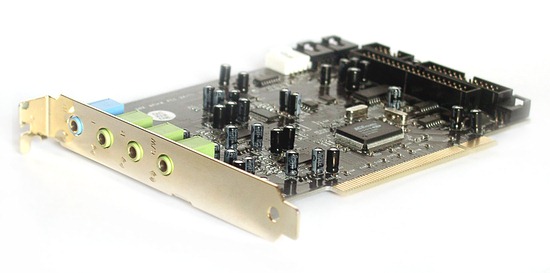 Terratec DMX 6fire sound card - gold-plated plank and metallic stereo minijack connectors The PCI card has three 3 linear connectors of the stereo minijack format for 5.1 acoustic system, as well as for 4-channel or simple stereo. The bracket also has a line-in; a mic-in is lacking. However, there is a mic-in with an amplification control on the commutation unit.  Terratec DMX 6fire sound card - front view The card has three internal analog connectors and a CD-Digital, which is not widely used anymore. The heart of the card is a professional PCI controller VIA/ICEnsemble ENVY24. This chip has a flexible and transparent signal routing system, high-quality mixing algorithms and doesn't let for any additional conversions in a signal. It allows for a per-bit accuracy of audio data delivery to codecs and true support of the 24/96 mode. This chip is very popular among manufacturers of audio equipment and is used, for example, in M-Audio Audiophile 2496, M-Audio Delta 410 and other cards.  Heart of the Terratec 6fire - Envy24 processor The card incorporates 3 well-known AKM AK4524 codecs. They are old and approved. They are installed in many sound cards in the range of $150-250. The external unit is connected to the card with a cable looking like standard IDE. The unit houses a heap of connectors and interfaces: line-in and line-out, turntable input, mic-in with volume control and clip led, adjustable headphones-out, digital optical and coax interfaces, standard MIDI interfaces with a DIN-5 connector.  External Terratec DMX 6fire commutation unit The unit doesn't contain any converters inside. A signal goes to the unit in the analog form via an unshielded bus, but its level is quite high. Our further measurements will show how it affects sound. Software and driversQuality and frequency of updates of the drivers are of the utmost importance today. Terratec has no problems here. The drivers are often updated, and we had no troubles with the 5.0.2000.125 WDM version tested under the WindowXP with the updates. The system also worked flawlessly with 3 sound cards installed together. PC test configuration:
Additional equipment:
A special control panel is provided for management of parameters of the 6fire card. The first tab contains elements for management of external interfaces. Signal indicators are provided and the regulators display values in dB in a 0.1 dB step. It places the card onto the professional level. Considering that the card is quite powerful and has plenty of features, its settings are not obvious. But it comes with a detailed and competent user's manual in English. 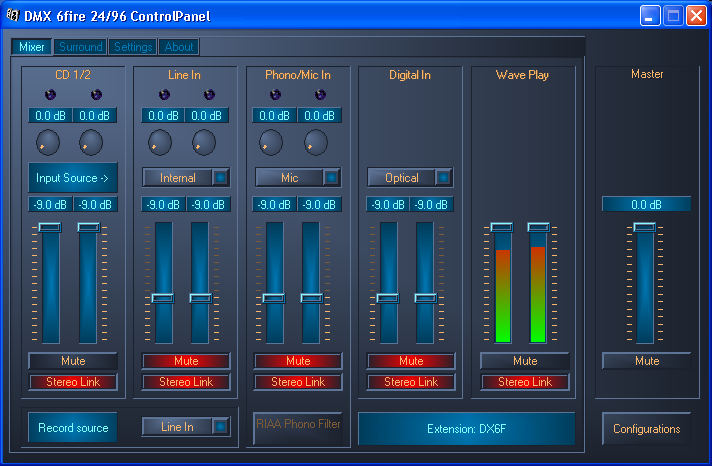 The second tab contains speakers' presets and volume control for each channel. There is also Enable Sensaura 3D switch which enables Sensaura algorithms (including EAX and I3DL2) in DirectSound3D applications.  "Settings" provide various fine settings like a DMA buffer size. By the way, color of the control panel can be adjusted to your liking.  The last tab is called About and it provides information on the drivers' version. 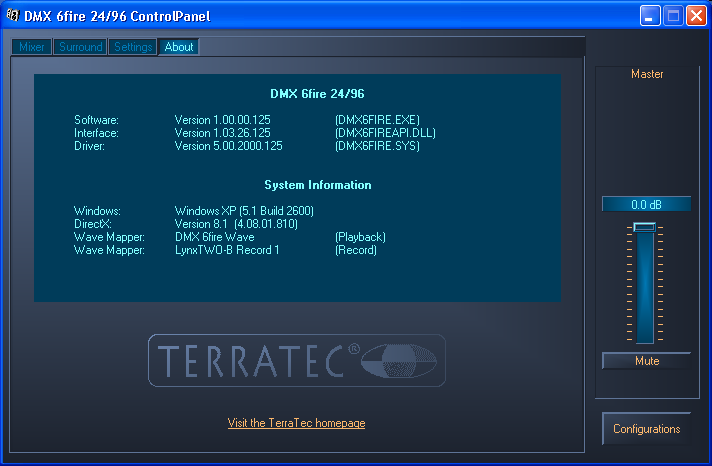 The software suite for the 6fire DMX is worth a good mark. On the one hand, you have a minimal set of programs for most practical needs. On the other hand, you don't have to overpay.
Line-OutAs the DMX 6fire and Audigy Platinum eX sound cards have professional music software and are positioned for home musicians, we listened to the test compositions on the near-field Event 20/20 bas monitors switching from one card to the other instantly. Test results:
RMAA measurementsLet's turn to the RMAA 4.0 program (http://audio.rightmark.org/). In measurements we used a Proel microphone stereo cable, 15 cm long, for each channel and standard unbalanced connection to the balanced input (Lynx Two reference card): hot = signal, cold = ground (the three-pin connection gave worse scores). The signal level of the receiver was standard: -10 dBV. The recording was fulfilled at -0.5 dB FS in the source to avoid odd overload. The Creative Audigy Platinum eX sound card was tested with the official universal drivers of 2002 developed for the whole Creative family. The Audigy card is a usual product, not a press-sample. 16-bit 44kHz modeThe 16/44 format is basic today: musical CD-DA, MP3 files, sound samples, applications and games using DirectSound/DirectSound3D. Terratec DMX 6fire, frontal output
General performance: excellent. Brilliant results! It's absolutely noiseless and lacks for any resampling hints. Creative Audigy Platinum eX, frontal output
General performance: very good. Here we have more distortions at 1 kHz and high intermodulation in high frequencies as a result of resampling from 44.1 kHz -> 48 kHz - it's a downside of all Creative cards. On the other hand, the real-time SRC (sample rate conversion) puts all distortions into the high-frequency range. However, when calculating the IMD we weigh the spectrum using the standard psychophysical curve "A" which is adequate to the human perception. That is why the Creative cards do not look advantageous in the IMD test. But in 2002 it's possible to give up that unnecessary recalculation on the cards with I2S codecs. In its new card - Extigy - the company lets us choose the reference frequency, at least. Well, the progress is evident.
For better understanding of operation of the RMAA test let me show you characteristics of the reference test signal produced by the cards. This is estimation of a generated test signal by the program. The characteristics are based on the dithering method and physical limits of the format. In the 16-bit 44.1kHz mode the cards come very close to the theoretical limit of the format. To improve quality of the sound it's necessary to turn to other data storage formats. 16-bit 48kHz mode16/48 is a reference frequency of DVD and MPEG4. DVDs with musical concerts often contain a stereo track exactly in 16/48 PCM. Terratec DMX 6fire, frontal output
General performance: excellent. The DMX 6fire drivers define a sampling frequency when playing files and then set a necessary mode for the codec. It's peculiar to all professional cards. To make possible to play files with different sampling frequencies, all lower frequencies are resampled to the maximum one for several audio streams. Well, it's quite a rational solution. Creative Audigy Platinum eX, frontal output
General performance: very good. The mark is very close to Excellent. But still, Creative should use higher-quality operational amplifiers for the line-outs.
24-bit 96kHz modeTerratec DMX 6fire, frontal output
General performance: excellent. The noise level, dynamic range and low distortions are impressive. This mode does make sense for the Terratec DMX 6fire card. Although the characteristics are far from the maximum of this format, they are more advantageous as compared with the 16/44 mode. Creative Audigy Platinum eX, frontal output
General performance: very good. At last, we have got>100 dB A SNR promised in the Audigy! But the absolute value of SNR doesn't make practical sense, we should look at the spectrogram for noise pickups. The Audigy has problems with the frequency response in the 24/96 mode, and I wish it had less distortions.
Well, the first prize still belongs to the LynxTwo. :) But it's much easier to realize good characteristics in an expensive card than in a mass one. That is why the Terratec DMX 6fire takes the rank of the first mass product which uncovers capabilities of the 24/96 format. The Audigy, which became a standard of multimedia cards, can play 24/96 files, and that's good. Hope Creative will soon come up with new cards with higher-quality playback in the 24/96 mode. The main problem of Creative consists in the 10K2 controller. It seems that it's not so easy to change the stuff imbedded into silicon preserving compatibility with everything. By the way, Extigy has no problems with FR in 24/96. Adjustable headphones-outWe compared sound quality of the WAV files of the 16/44 and 24/96 formats. The Sennheiser HD600 headphones used in this test are considered the best ones among audiophiles.  External commutation unit of the Audigy Platinum eX and Sennheiser HD600 headphones In Audigy data is transferred in a digital form via a thick shielded cable outside the computer. And in the DMX 6fire a signal goes in an unshielded 0.5m flat cable inside the system unit. The headphones-out on the Behringer console serves as the reference solution with the Lynx Two professional card. The listening tests in the Sennheiser HD600 headphones give the following results:
Well, the headphones-out lie stronger than even line-outs of the cards - I mean cards for listening on high-quality equipment which has a price comparable or higher than that of the cards. Headphones output: DMX 6fire vs. Audigy Platinum eXTest path: headphones-out - Lynx Two line in (-10 dBV signal level).
Professional applicationsCapabilities of both tested cards get uncovered only with the ASIO interface. Exactly in the ASIO mode the cards get multiple inputs and outputs which can be used independently. Contrary to Audigy, 6fire has finer and wider settings for the professional APIs.  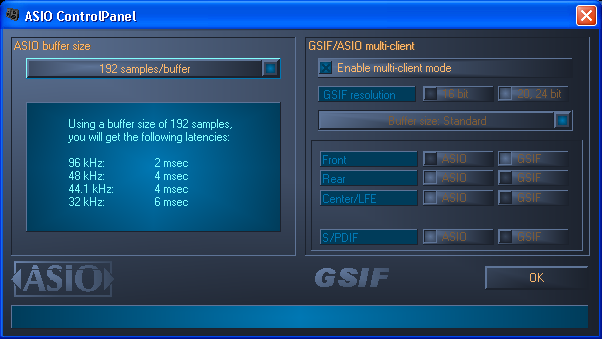 The GSIF is supported (interface for virtual Gigasampler and Gigastudio samplers). But today it's fashionable to use sequencers' native samplers - VSTi and DXi tools. I mean HALion, LM4, LM9, VB1 and others. We tried the cards in the new Steinberg Cubase SX sequencer which looks like a combination of the Cubase VST 5 and Nuendo. The DMX 6fire had no problems. And the Audigy gives incorrect sound in the 16/44 mode. We didn't have such problems in the previous Cubase versions, that is why it looks like a bug of the sequencer. 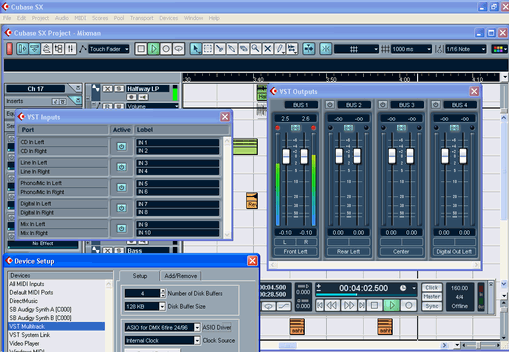 Terratec DMX 6fire in the Steinberg Cubase SX sequencer  Audigy Platinum eX in the Steinberg Cubase SX sequencer Creative recommends using the Audigy card in the 48 kHz mode. The card comes with a program of quality resampling from 44 into 48 and back. Apart from Steinberg Cubasys VST, Wavelab Lite and ReCycle, the Audigy card is equipped with an excellent guide for music composing on a computer: The definitive music creation guide, Paul White. GamesAs both cards are multimedia solutions they have to work well in games. And they do cope with it. Undoubtedly, the Creative's models take the palm, because this company is an absolute leader in development of gaming APIs - EAX1, EAX 2 and EAX Advanced HD aka EAX3. Realistic sound in games, especially in 3D shooters, is much spoken about. But I think that environment created by a gaming program is more important. Just take a sound track in movies: nobody records sound right on a shooting area however realistic the sound can be. But they add a lot of sound effects during postscoring and sound editing to make impression stronger. It's all the same in games. The more skillfully the sound is plaited into the thread of the game's plot, the more pleased users are. All modern sound technologies are oriented toward such environment. The third reincarnation of the EAX offers using algorithms as a part of the DirectSound/DirectSound3D API or by means of OpenAL extensions. In the latter case, even if a sound card doesn't support EAX3.0 entirely, the EAX Unified mechanism converts calls of the EAX3.0 into calls of EAX2.0, thus, preserving upward compatibility.  We tested the cards in the Unreal Tournament 2003, Jedy Khight II, Soldier of Fortune 2, WarCraft III, Neverwinter Nights games. The Audigy gave excellent sound. The reverb quality and 3D effects are impeccable. Besides, quality of mixing of sound streams of the Audigy is top-notch. All sounds are clear and saturated, all effects are well discernible. Thanks to the Sensaura support the Terratec card copes with the games quite well, but it still loses to the Audigy in quality. DirectSoundMany are interested in a cost of the software DirectSound (and Sensaura API) support of the 6fire card. There are no many tests measuring CPU load with a different number of streams. ZD Audio WinBench 99 is a quite good benchmark of 1999. But it has some disadvantages: it's developed for DirectX 3.0, has the only test sample of 22 kHz and it's unknown what it measures and how. For measuring CPU load we have developed our own program called RMAA DirectSound. It will soon be available free of charge. It gives DirectSound diagnostics according to characteristics of the drivers and card libraries.   It's also possible to measure CPU load and estimate quality of channel mixing with the number of streams specified (audio buffers, according to DirectSound API). When measuring the CPU load you can use the measuring tool integrated into the OS (for XP) or a special more precise algorithm.  The test gives both an average value and deviation (or rather, root square of standard deviation), which allows estimating data more adequately. There is a special algorithm that excludes random values from the distribution which is based on the statistical analysis and discarding of values which do not get into a confidence interval (at the confidence level of 0.95).  Let's compare the CPU usage for the Terratec 6fire measured with two different methods. RMAA DirectSound, 2 speakers mode, Windows XP, Sensaura ON, 500 ms update time
The standard measuring method doesn't suit for a small CPU load because of a too high deviation. The measurements were carried out during playing the files of 20 seconds in the 16-bit 44.1kHz format. The test configuration is the following: CPU Athlon XP 2100+, 512 Mb DDR333, Albatron KT333. RMAA DirectSound, Windows XP, Sensaura ON, 500ms update time
A typical situation in games is simultaneous reproducing of 8 to 16 voices. The Audigy advantage is a couple of percents. The Audigy outscores its competitor in stream mixing quality. With the Sensaura disabled the drivers of the DMX 6 fire card turn to the mode of software DirectSound algorithms. This is the mode which we recommend for playing music in universal WAV/MP3 players Windows Media Player and others using DirectSound API. ConclusionThe Terratec DMX 6fire sound card will be interesting mainly for those who value high-quality sound and for owners of high-quality acoustic systems. The sound quality is obtained with the professional Envy24 chip, AKM codecs and quality drivers supporting both professional and gaming APIs. Contrary to professional sound cards of the same price niche, the card possesses a 5.1-channel output and supports 3D sound in games based on the Sensaura algorithms. The Creative Audigy Platinum eX offers a more powerful gaming support - EAX 3.0, that is why it will suit advanced gamers and owners of computer acoustic systems. Write a comment below. No registration needed!
|
Platform · Video · Multimedia · Mobile · Other || About us & Privacy policy · Twitter · Facebook Copyright © Byrds Research & Publishing, Ltd., 1997–2011. All rights reserved. | ||||||||||||||||||||||||||||||||||||||||||||||||||||||||||||||||||||||||||||||||||||||||||||||||||||||||||||||||||||||||||||||||||||||||||||||||||||||||||||||||||||||||||||||||||||||||||||||||||||||||||||||||||||||||||||||||||||||||||||||||||||||||||||||||||||||||||||||||||||||||||||||||||||||||||||||||||||||||||||||||||||||||||||||||||||||||||||||||||||||||||||||||||||||||||||||||||||||||||||||||||||||||||||||||||||||||||||||||||||||||||